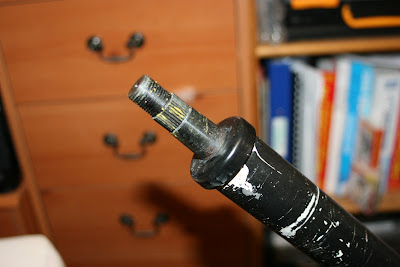
Here's the batteries on the right hand side. I've used T-105's a 6v, and have 6. I'm hoping to go up to 48V by adding two more in the rear tray. I've used heavy gauge cables that I can make up myself quite nicely now, all soldered and sealed. The fuse box on the left is for the rear light feed that's run from the dash and then under the cart to hear. The cables then run through the gap behind the seats into the rear area.

Here's the cross bar between the seats showing the handbrake and 48V solenoid. At the moment, this runs fine on 36V, and is rated at 600A continous so is beefy enough for the 48V conversion I'm planning later. There's the stock F-R switch, cleaned up. Below this is a modified accelerator board I made to power the Curtis 1206 speed controller at the rear. I just pulled out the standard pins and fixed in a 0-5k pot with a rack and gearwheel. Works beautifully and give very precise control at low speeds. The wiring running along the corssbar goes to the speed controller and the handbrake warning light switch. I've taken out the reverse buzzer and am using the feed for to power a reversing lamp at the rear instead (all off the 12V electric system).
 Here's the motor. I've removed the flywheel and brake as I want to replace this with a more powerful unit in future, and have instead put on rear drums with a dual hydraulic/cable unit. There are photos of this later. This has to be done to satisfy the UK road legal requirement that you must have mechanically seperate brake and handbrake systems, and both must be progressive. There is also plug braking from the controller, but this doesn't satisfy the road legal requirement. Anyway, on this cart, I now have 3 seperate braking systems on one axle. Just part of the gymnastics you need to go through to get through an MOT test.....
Here's the motor. I've removed the flywheel and brake as I want to replace this with a more powerful unit in future, and have instead put on rear drums with a dual hydraulic/cable unit. There are photos of this later. This has to be done to satisfy the UK road legal requirement that you must have mechanically seperate brake and handbrake systems, and both must be progressive. There is also plug braking from the controller, but this doesn't satisfy the road legal requirement. Anyway, on this cart, I now have 3 seperate braking systems on one axle. Just part of the gymnastics you need to go through to get through an MOT test.....
Here's the curtis controller mounted where the resistors used to be. If you've got this cart, I reckon removing these is the best upgrade you can do, period. You get bags better range. Also, on the other 212 i did first, it's used around a farm and they have big issues with the resistors setting fire to long grass in summer as you drive though. Crazy...
The charging socket on the right is only temporary. There are also two seat post locks on each side with springs attached. These are to lock the seats in place whilst driving, again another road legal requirement here. You can also see the lap belt posts I've put in here. These are M12 bolts anchored to the main chassis for strength. In the rear tray, there's the rear light cluster wiring for the brake/fog/reverse/tail lights. This will be completed next.












